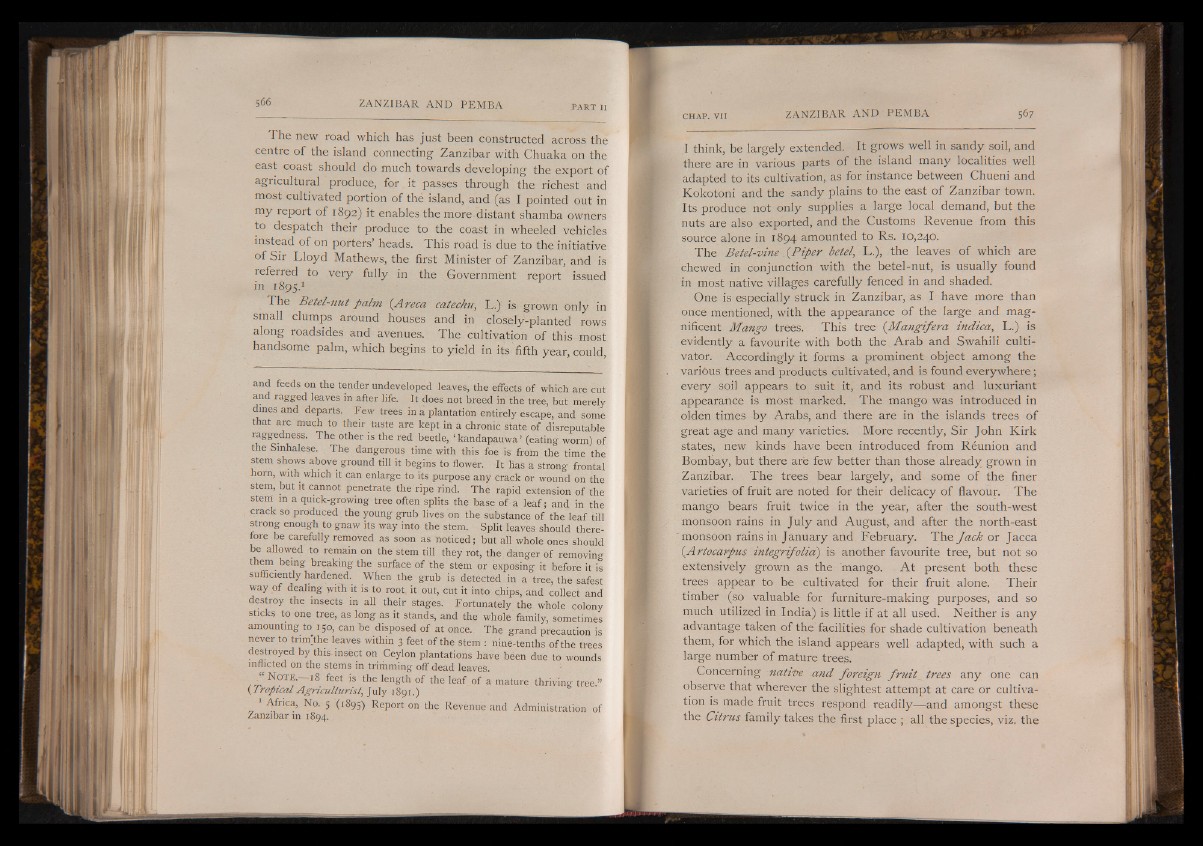
The new road which has just been constructed across the
centre of the island connecting Zanzibar with Chuaka on the
east coast should do much towards developing the export of
agricultural produce, for it passes through the richest and
most cultivated portion of thé island, and (as I pointed out in
my report of 1892) it enables the more distant shamba owners
to despatch their produce to the coast in wheeled vehicles
instead of on porters’ heads. This road is due to the initiative
of Sir Lloyd Mathews, the first Minister of Zanzibar, and is
referred to very fully in the Government report issued
in 1895.1
The Betel-nut palm (Areca catechu, L.) is grown only in
small clumps around houses and in closely-planted rows
along roadsides and avenues. The cultivation of this most
handsome palm, which begins to yield in its fifth year, could,
and feeds on the tender undeveloped leaves, the effects of which are cut
and ragged leaves in after life. It does not breed in the tree, but merely
dines and departs. Few trees in a plantation entirely escape, and some
that are much to their taste are kept in a chronic state of disreputable
raggedness. The other is the red beetle, ‘ kandapauwa’ (eating worm) of
the Sinhalese. The dangerous time with this foe is from the time the
stem shows above ground till it begins to flower. It has a strong frontal
horn, with which it can enlarge to its purpose any crack or wound on the
stem, but it cannot penetrate the ripe rind. The rapid extension of the
stem' in a quick-growing tree often splits the base of a leaf ; and in the
crack so produced the young grub lives on the substance of the leaf till
strong enough to gnaw its way into the stem. Split leaves should therefore
be carefully removed as soon as noticed; but all whole ones should
be allowed to remain on the stem till they rot, the danger of removing
them being breaking the surface of the stem or exposing it before it is
sufficiently hardened. When the grub is detected in a tree, the safest
way of dealing with it is to root it out, cut it into chips, and collect and
destroy the insects in all their stages. Fortunately the whole colony
sticks to one tree, as long as it stands, and the whole family, sometimes
amounting to 150, can be disposed of at once. The grand precaution is
never to trunthe leaves within 3 feet of the stem : nine-tenths of the trees
destroyed by this-insect on Ceylon plantations have been due to wounds
inflicted on the stems in trimming off dead leaves.
“ N o t e .— 18 feet is the length of the leaf of a mature thriving tree.»
{Tropical Agriculturist, July 1891.)
Africa, No. 5 (1895) Report on the Revenue and Administration of
Zanzibar in 1894.
I think, be largely extended. It grows well in sandy soil, and
there are in various parts of the island many localities well
adapted to its cultivation, as for instance between Chueni and
Kokotoni and the sandy plains to the east of Zanzibar town.
Its produce not only supplies a large local demand, but the
nuts are also exported, and the Customs Revenue from this
source alone in 1894 amounted to Rs. 10,240.
The Betel-vine pPiper betel, L.), the leaves of which are
chewed in conjunction with the betel-nut, is usually found
in most native villages carefully fenced in and shaded.
One is especially struck in Zanzibar, as I have more than
once mentioned, with the appearance of the large and magnificent
Mango trees. This tree (Mangifera indica, L.) is
evidently a favourite with both the Arab and Swahili cultivator.
Accordingly it forms a prominent object among the
variôus trees and products cultivated, and is found everywhere ;
every soil appears to suit it, and its robust and luxuriant
appearance is most marked. The mango was introduced in
olden times by Arabs, and there are in the islands trees of
great age and many varieties. More recently, Sir John Kirk
states, new kinds have been introduced from Réunion and
Bombay, but there are few better than those already grown in
Zanzibar. The trees bear largely, and some of the finer
varieties of fruit are noted for their delicacy of flavour. The
mango bears fruit twice in the year, after the south-west
monsoon rains in July and August, and after the north-east
monsoon rains in January and February. The Jack or Jacca
(A rtocarpus integrifolia) is another favourite tree, but not so
extensively grown as the mango. A t present both these
trees appear to be cultivated for their fruit alone. Their
timber (so valuable for furniture-making purposes, and so
much utilized in India) is little if at all used. Neither is any
advantage taken of the facilities for shade cultivation beneath
them, for which the island appears well adapted, with such a
large number of mature trees.
Concerning natitre and foreign fru it trees any one can
observe that wherever the slightest attempt at care or cultivation
is made fruit trees respond readily— and amongst these
the Citrus fâmily takes the first place ; all the species, viz. the